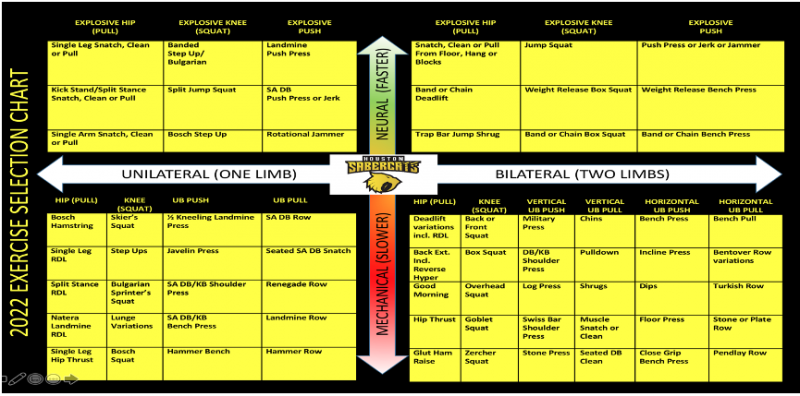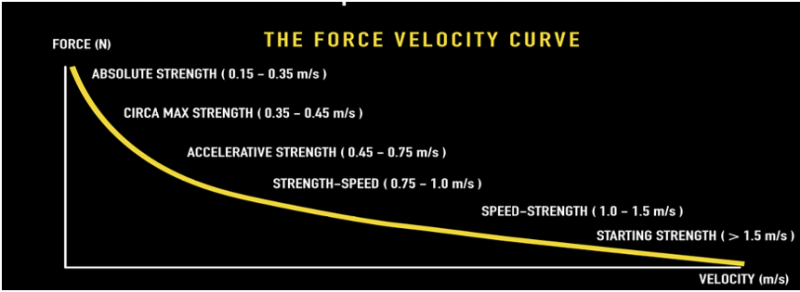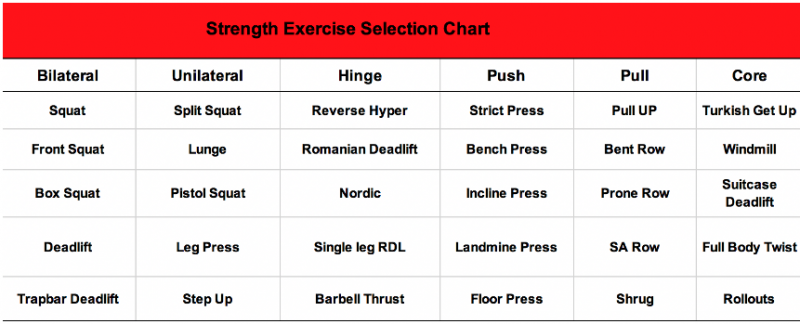
The starting point of my Quadrant Management System (QMS) is the Exercise Selection Chart. This chart allows all players to begin the journey in the system with the first degree of freedom: exercise selection.
For those of you reading this who have not been exposed to the QMS previously, read these two elitefts articles:
- The Four Year College Strength Program: An Alternative Management Perspective (Nov 16, 2016)
- Program Determination Using the Quadrant Approach: Individualization in a Team Sport Environment (Aug 23, 2017)
It is always the first task I place on myself when I arrive in a new facility. I walk through the weight room and assess what we have to work with and list what might be available to purchase with the budget we have available. Then from there, I list every possible exercise that can be performed with the equipment currently on hand to work with. After this is done, the next step is to determine the categories of exercises you wish to promote to the playing group and concurrently ask WHY you want that particular category.
I have used a number of variations in this category selection over the last decade or more. The determination is based on many variables that you will need to consider starting with your philosophy of training, then also looking at the playing group that you have attempted to ascertain where they are in their training age development and needs of strength training for the coming period of time. Your final determination will never be permanent as you can see from the attached copies. The category selection is very fluid over time, but what is not fluid is the degree of education that has to be given to the playing group. So, they understand the WHY of the category and assisting them in making good choices for their level of training age and specific needs in order to transfer the gains in the gym to the playing surface.
In my latest exercise selection chart, I have attempted to combine both aspects of my training philosophy and also both pre-season and in-season programming choices—ensuring that I had both unilateral and bilateral options for the players to select from. I tend to develop programs working specifically at either end of the force-velocity curve. I term these neural (explosiveness) and mechanical (more force-related).
In my latest chart above I have taken out plyometrics, loaded carries, and medicine ball throws and given them another table which will be incorporated into an overall gym training philosophy chart from which the day-to-day programming and ongoing player education will be based on.
You can see this relationship clearly when overlaying the training speed parameters of velocity-based training (VBT) over the force-velocity curve, as per the diagram. Nicholas Bronkall does a wonderful job of explaining programming using the Force-Velocity curve in this article. I would also encourage you to read the work of Tim Suchomel, Paul Comfort, Bryan Mann, and Dan Baker on the use of weightlifting derivatives and velocity-based training to target key strength sub-categories along the curve.
With younger training-age athletes, I have selected categories to ensure that they are sticking to the basics to develop good technique on the major movements that have stood the test of time.
Samoa Rugby Weight Room Exercise Selection Chart
Upper Body Push
- Bench Press
- Incline Bench Press
- Floor Press
- Trap Bar Shoulder Press
- Military Press
- Half-Kneeling Landmine
- Jammer
- Push Press
Upper Body Pull
- Bent Row
- Pendlay Row
- Chins
- Trap Bar Row
- Shrugs
- Seated Row
- Dumbbell One Arm Row
- Pulldown
Lower Body Push
- Front Squat
- Back Squat
- Jump Squat
- Leg Press
- Sprinter's Squat
- Box Squat
- Lunge Variations
- Step-Up Variations
Lower Body Pull
- Snatch
- Clean
- Pull/Shrugs
- Deadlift
- RDL
- Back Extensions
- Hip Thrust
- Glute Ham Raise
Extra's—Loaded Carry
- Farmer's Walk
- Prowler® Push
- Sled Drag
- Overhead Carry
- Zercher Carry
- Tire Flip
- Yoke Walk
- Suitcase Carry
Extra's—Loaded Core
- Suitcase Deadlift
- Windmill
- Russian Twist
- Barbell Sit-Up
- Renegade Row
- Roll Outs
- Turkish Get-Up
- Full Body Twist
I also often delimit the number of choices after consulting with the playing group. I conduct a poll of all players asking them to give me their five go-to exercises for each of the categories and formulate this information into the chart.
Finally, with advanced groups who have a good knowledge of the aspects of strength training related to the force-velocity curve, I will expand on the ideas above and have categories for strength-speed and speed-strength included. Ideally, you will have access to Gym Aware or Tendo Units or something similar to assist in this decision-making and selection process.
One of the key outcomes I am attempting to get by using the QMS is for the playing group to understand the WHY of the choices and the processes involved with this. When the playing group understands the WHY, then I have found that the buy-in and compliance are very high, actually close to 100 percent of the playing group. The by-product of this is the building of self-reliant players and decision-makers which transfers to all aspects of sporting performance, both on and off the field in the team culture as well as in player's lives away from the sport.
Ashley Jones has just completed his 30th pre-season in professional sport. He has worked across three professional sports on four continents and currently plies his trade in Major League Rugby (MLR) with the Houston Sabercats as their Head of Performance.
















Thanks again! Cheers,
Ashley we are going to need to compile all of your articles into a handbook for coaches.
Always look forward to your stuff.
I am trying to get in contact with you about a presentation you did at the Coaches Conference in San Antonio in 2020. Can you email me?
Thanks!
https://www.nsca.com/education/videos/warm-up-games-for-all-sports/